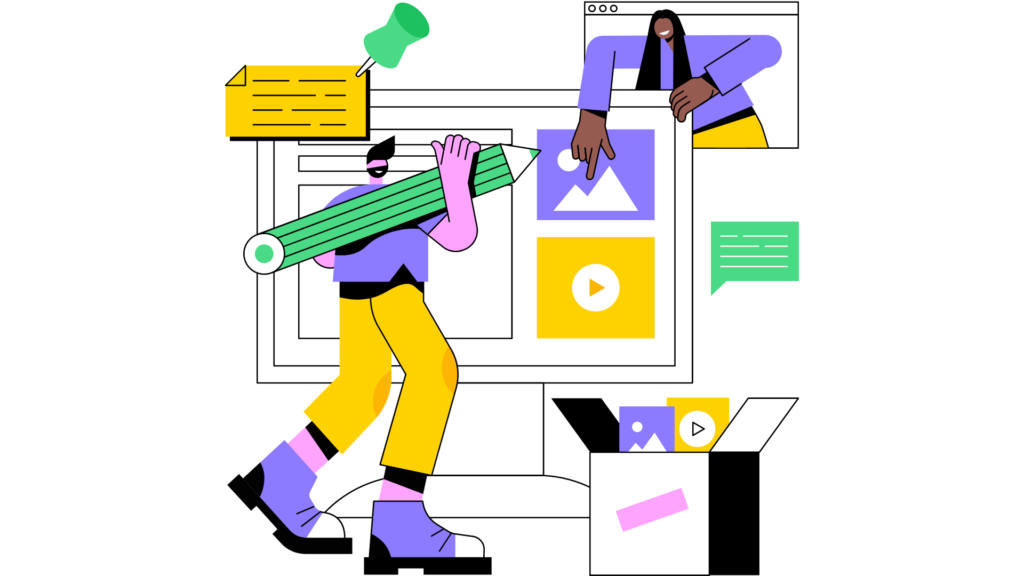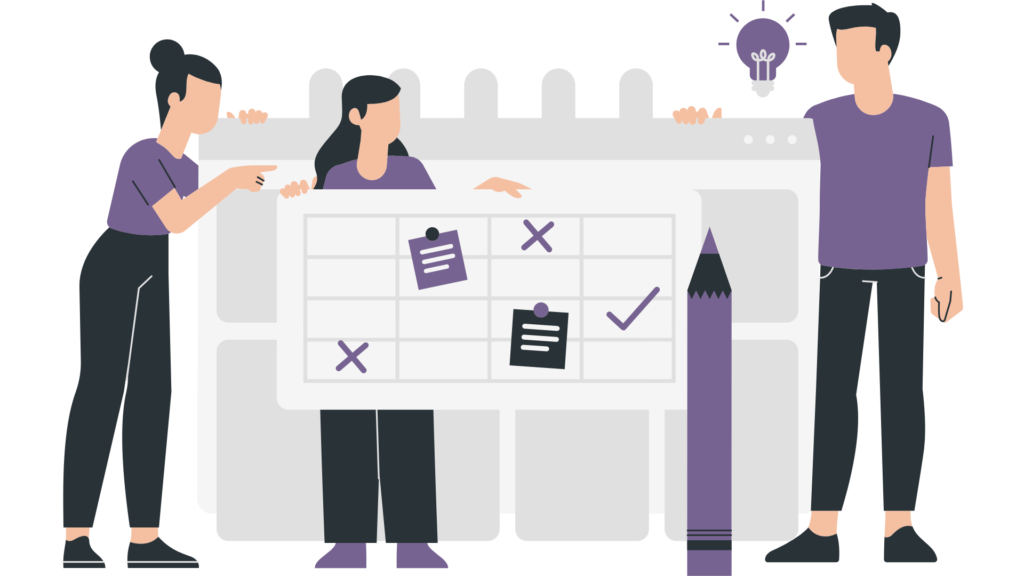Strategic Media Alliance 2: Content co-creation Copy Copy
SMA 2: Content co-creation

This is the second Strategic Media Alliance strategy. We will introduce the principles of creating engaging and persuasive content as well as different outputs participants can consider. Also, we will share some tips and tricks for the co-creative approach.
Principles of content creation
In other trainings we go more in-depth on the process of content creation, however, we wanted to give an overview of the main things to consider when creating content.
- Define your message: a) what is your message about, b) who are you talking to, c) why are you delivering this information to these audiences?
- Define the content: a) what type of content you are creating (video, text, infographic, etc.), b) what is the format of this content, c) how long is it?
- Define the platforms: which platforms are best suited to present your content?
- Define roles & responsibilities: who is doing what during the collaboration?
- Define timeline & budget: resources needed and necessary deadlines
Key questions
The following questions are aimed to assist you in the process of creating your content. Make sure the content responds to the purpose and the goals of your organisation.
WHAT – This is the central question to answer: what is our main topic to approach with our content? What do we want this content to tell? This might determine the format of our content; what format suits us best.
WHO – Who is this content for? Who are we talking to with the content we are creating? Who are they, what do they watch, and what do they think? This might also determine the platforms we use to disseminate the content.
WHY – This question wants to answer the purpose of this content. Why are we making this content? Why do we feel the drive to make this content?
Define your content
After having a clear idea of the purpose and strategy of your content by answering the key questions stated before, now is the time to define the content. This means grounding the ideas into specific plans and taking some decisions to support them.
Type | This refers to the medium we will use to create the content. For example, a text can be a blog, an article, etc. An image can be a photo for a campaign, a series of photos for a report, mixed media can be infographics. |
Format | A format relates to the form that our content will take. The BBC created a frame to understand formats divided into single and wrapper formats. We will go more in-depth about formats shortly. |
Duration | Think of it both in terms of singular content or serial content but also in terms of minutes in the case of podcasts or videos. |
Creative formats

What is a format?
A format is simply a way in which elements of a story (the rising tension) are structured in order to tell the story. Many creators of content refer to the sequence of ingredients of a programme or piece of content as its unique format. For instance, the show “Big Brother” has a set number of elements that are replicated throughout the world as the show’s unique format – we will explore this secondary definition of a format later. If the definition of story is “something that happens to someone that teaches us something”, the definition of format would be “the ways in which a story can be told”. It refers more to the mechanics or layout of the story than the story itself.
In the world of traditional and online media, the language used to describe the ways to tell stories and what makes the various types of formats unique, differs greatly. This is not only true from country to country but also among different broadcasters and content creators. Consider the words “Feature” or “Documentary”, both are used to explain a range of products.
Whatever name you give them, there are essentially 10 ways stories can be presented to an audience. Each of the 10 formats uses the information or logic of the story in different ways. Some of the formats are good at presenting facts and information and some are poor at holding information. Some of the formats are particularly good at emotion and some are bad at holding emotion. The format that you choose should depend on what you want the audience to experience.
Single and wrapper formats
Formats can be broken up into SINGLE and WRAPPER formats. Single formats are like primary colours; they exist singularly and can be combined in ways that create new colours. So, for example, blue and yellow make green. By combining two different formats, you have created a different format.
When you look at the 10 formats, you will notice that there is no listing of words you may have heard before such as “Documentary” “Feature” or “Reality”. These have been used to describe formats, but they are misleading. If we were to ask a group, “What is a documentary?” many people will have different ideas of what a documentary is or examples of ‘documentaries’. This makes the word problematic. So are the words “Feature” and “Reality”. The word feature may refer to a feature film (a film over 90 minutes), a news feature (meaning a big story usually over many pages in a newspaper) or a personality feature (a particular person who features in a story). As you can see from these examples, the words used are unspecific and could be interpreted in different ways.
Single formats
Single formats, as mentioned above, are simple, basic formats that can be used alone or in combination. There are five single formats. It usually helps to think of these as primary colours (Red, Yellow, Blue).
FORMAT NAME | FORMAT DEFINITION |
DRAMA | Drama is any information or story that is presented to an audience by actors. The audience will know that what they are watching is DRAMA if they are aware that the people in the story are actors and not real people. Drama is the only psychological format, meaning that it is the one format in which we understand what is in the character’s mind. Drama is the most consumed format and uses the story to deliver a strong emotion to an audience. |
TESTIMONIAL | A testimonial or testimony is a person or people who deliver their own story or viewpoints on a certain topic directly to the audience. The difference between testimony and interview is that testimony is a personal story or views delivered directly to the audience, without intervention or questions by someone else. Sometimes interviewers edit out their questions so the interview appears to be a straight testimony. Testimony can be really powerful if the person talking can explain their story in a powerful way, using rising tension, a symbol and other essential elements of the story. |
INTERVIEW | Interviews are structured by the questions the interviewer asks the interviewee. A powerful interview has carefully formulated and sequenced questions, so the story told builds in tension answering a central question. |
DISCUSSION | Discussions are simply a group of people expressing opinions or arguing. The discussion will have a group of 3 or more people exchanging opinions on a given topic. The story comes from the quality of the opinions or arguments. |
DEMONSTRATION | Demonstration relies on a person showing us a process or skill in a step-by-step manner. The story comes from the process – the sequence of steps. |
Wrapper formats
Now that we understand the five single formats (drama, testimonial, interview, discussion and demonstration) let’s look at the Wrapper Formats. Wrappers are formats that use single formats in a combination of ways. A wrapper is a way that one or more single formats are presented. It can hold lots of different single formats. The wrapper format is very popular in television and radio, and new and exciting programmes are created by changing the contents of the wrapper formats. A good way to think about these is by thinking about cake. If you have ever baked a cake you know that there are always the same list of basic ingredients: milk, flour, eggs, and sugar. By using more of one and less of the other, or by adding new ingredients you get different types of cake: chocolate cake versus vanilla, light and fluffy versus solid with nuts. The wrapper formats of television are the same.
There are five types of wrapper formats, they are: Magazine Programme, Report, Actuality, Montage, and Game. Wrappers can hold single formats and other wrappers within their structure.
FORMAT NAME | FORMAT DEFINITION |
MAGAZINE | A magazine format relies on links by a presenter or presenters. The story is told by linking one item to the next. The typical format is link-item-link-item-link. In a magazine, the logic of the format comes from the links. Most often these will have a theme or general topic that they cover such as “Sports” or “Lifestyle”. |
REPORT | A report is a single subject that is explored by a reporter. The reporter can be seen or can be just a voice that guides our understanding of the content. The report usually has a number of items in it that the reporter guides us through, most often Interviews, Testimony and Discussion are used, however, the report can feature others. |
ACTUALITY | Actuality refers to live, unedited events as they happen. Live events such as sports games or matches, a concert, a press conferences or a presidential addresses are often presented live and unedited. However, while waiting for the President to speak, during the concert pause or during game halftime, other formats like interviews, discussions or even reports may be inserted, turning Actuality into a wrapper. Actuality wrapper can contain many other formats. |
MONTAGE | Relies on editing to tell a story. Editing is the process of taking different shot footage, quotes or sound clips and putting them together to tell a story. Montage is similar to a report, in that it usually explores one subject, however, it does not have a reporter or a voice-over explaining it. It relies completely on editing. Montage has become a very popular format since the rise of MTV – music videos are essentially just editing. |
GAME | Game format is anything that contains rules. In a game format, the rules tell the story. Generally, these rules build tension for the audience. Really engaging games have interesting rules that have a payoff when the contestants win or lose or overcome the obstacles or rules. |
Medium & channel
In this training, when we use the term medium, we are referring to the form the sender has chosen to reach his receiver. The choice of medium depends on who the audience is and what the message is.
VIDEO | AUDIO | TEXT | ON THE GROUND | VISUAL |
Animation Short Videos Vlogs Long-form Montages 3D Immersive/VR Live Broadcasts | Podcast Radio Sound Bites Audio Notes Songs Jingles Themes | Articles Written Reports Essays Typography Idea Clouds Blogs Tweets Billboards Poster Surveys Quizzes Letters Lists | Face-to-Face Meetings Interviews Press Releases Events Promotion Flashmobs Graffiti Takeovers Theatre/Plays Activations Town Halls Demos/Strikes | Graphics Photos Photo Essays Charts Graphs Banners |
To put it simply, a medium is how the content is presented. For instance, a video, graph, or article. A channel is where the content can be found. For instance, on television, in a cinema, on a display screen or on platforms like Facebook, Instagram or YouTube.
We make a distinction between traditional media channels and digital media channels. Digital channels surged with the invention of the internet, which became a widespread tool for accessing information.


TRADITIONAL MEDIA CHANNELS | DIGITAL MEDIA CHANNELS |
Hardcopy Press: Newspapers, Magazines, Periodicals. Radio: shortwave, long wave and ham radio. Direct Marketing: Mail, telephone, push SMS Outdoor/Traditional Display: Billboards, Posters Television: Community TV, National Broadcasters, Satellite TV, Merchandising and Sponsorships Cinema | Online Video: YouTube, Vimeo Social Media: Facebook, Instagram, Twitter, Facebook Groups, VK, Weibo, WeChat, Pinterest, Snapchat, LinkedIn, TikTok Direct Messaging Applications: WhatsApp, Telegram, WeChat, Facebook Messenger Email Marketing Augmented Reality In-Game Advertising |
Collaboration Strategies
Collaborating is always a practice of listening and discovery, you need to find out what works best for you and your team and always be on the lookout for things that can be improved along the way. With this in mind, we have compiled a few things to help set out a good basis for the collaboration.
Roles & responsibilities
The roles and responsibilities will depend on the type of project you develop, the people involved, and the scope and needs of the project. It will also be determined according to the type of content you will be creating.
Guiding principles:
- Understand your team’s strengths.
- Determine what needs to get done.
- Meet to discuss priorities on an ongoing basis.
- Give people ownership over specific areas.
- Ask people about their long-term goals.
- Align roles and responsibilities with their goals.
Project timeline

A project timeline is a temporal breakdown of the production process of the product you want to create. You need to be as realistic as possible and consider the amount of work needed and how this work will be distributed. In content creation, the production process often is divided into three stages: pre-production, production, and post-production.
As an overview the following elements should be considered for the timeline:
- Expected Duration
- Stages of production (pre-production, production, post-production)
- People involved and hours of work expected
